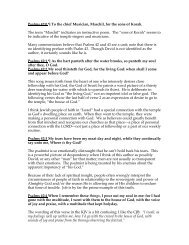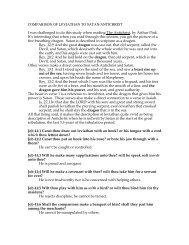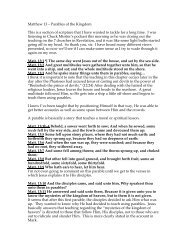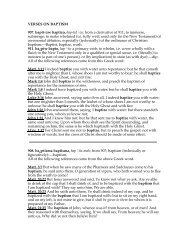Comparison of Matthew 24-25, Mark 13, and Luke 21 - Mom's Bible ...
Comparison of Matthew 24-25, Mark 13, and Luke 21 - Mom's Bible ...
Comparison of Matthew 24-25, Mark 13, and Luke 21 - Mom's Bible ...
- No tags were found...
You also want an ePaper? Increase the reach of your titles
YUMPU automatically turns print PDFs into web optimized ePapers that Google loves.
In light <strong>of</strong> today <strong>and</strong> looking back on history, that is an interesting distinction to make. The wars <strong>and</strong> commotions willinclude fighting between the races as well as fighting between kingdoms, “peoples united under a commonruler/authority.”Arnold Fruchtenbaum provided some interesting insight on the Jewish origin <strong>of</strong> “nation against nation, <strong>and</strong> kingdomagainst kingdom.”“This expression, found in Jewish sources such as the Bereshit Rabbah (written shortly after Yeshua’s time) <strong>and</strong>,later, the Zohar Chadash—is a Hebrew idiom for a world war. What Jesus was saying, then, is that it would be aworld war rather than merely a local war that would mark the beginning <strong>of</strong> the end <strong>of</strong> the age.”Regarding World War I <strong>and</strong> II: “Both wars had a decisive impact on Jewish history. The first gave impetus to thegrowth <strong>of</strong> the Zionist movement, <strong>and</strong> the Second World War led to the re-establishment <strong>of</strong> the Jewish State.”Added to wars/commotions would be:1. famines (MML)2. pestilences (Matt/L) - loimos, loy´-mos; a plague (literally, the disease, or figuratively, a pest):—pestilence(-t).3. earthquakes (MM), great earthquakes (L) in divers/various places (MML)4. troubles (<strong>Mark</strong>) - tarache, tar-akh-ay´; disturbance, i.e. (<strong>of</strong> water) roiling, or (<strong>of</strong> a mob) sedition:—trouble(-ing).5. fearful sights <strong>and</strong> great signs from heaven (<strong>Luke</strong>)<strong>Matthew</strong> <strong>and</strong> <strong>Mark</strong> clarify that these signs will only be the beginnings <strong>of</strong> sorrows.“sorrows” - (odin, o-deen´; a pang or throe, especially <strong>of</strong> childbirth:—pain, sorrow, travail.)The point being made is that these signs would indicate the onset <strong>of</strong> birth pangs; the onset <strong>of</strong> signs that would culminatein His return <strong>and</strong> the end <strong>of</strong> the age—in their mind, the establishment <strong>of</strong> Christ’s kingdom. Comparing the signs tochildbirth indicates that they would eventually increase in frequency <strong>and</strong> intensity as the time for fulfillment drew near.It’s interesting to note how these verses compare to seals 1-4 in chapter six <strong>of</strong> Revelation; this emphasizes that the birthpains will find culmination in the judgment to come.Revelation 6:1–8 “And I saw when the Lamb opened one <strong>of</strong> the seals, <strong>and</strong> I heard, as it were the noise <strong>of</strong> thunder, one <strong>of</strong> the four beastssaying, Come <strong>and</strong> see. And I saw, <strong>and</strong> behold a white horse: <strong>and</strong> he that sat on him had a bow; <strong>and</strong> a crown was given unto him: <strong>and</strong>he went forth conquering, <strong>and</strong> to conquer. [My note: This is Satan coming to take control <strong>of</strong> the world eventually byindwelling the person <strong>of</strong> the final Antichrist—the final false Christ.] And when he had opened the second seal, I heard thesecond beast say, Come <strong>and</strong> see. And there went out another horse that was red: <strong>and</strong> power was given to him that sat thereon to take









